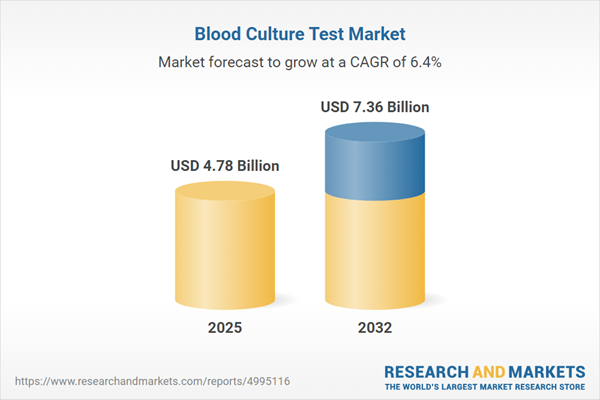Speak directly to the analyst to clarify any post sales queries you may have.
The blood culture test market is becoming increasingly vital for healthcare organizations seeking operational resilience, efficiency, and improved infection management. As laboratory automation and advanced diagnostics become core to infection control strategies, leaders must evaluate scalable solutions to meet evolving clinical, regulatory, and procurement demands.
Market Snapshot: Growth and Trends in the Blood Culture Test Market
The blood culture test market continues to exhibit steady growth, driven by greater emphasis on advanced sepsis diagnostics and adoption of automated laboratory solutions. Enhanced molecular testing technologies, such as polymerase chain reaction and next-generation sequencing, support faster and more precise pathogen detection, shaping new protocols in infection control. This technological evolution helps laboratories provide timely diagnostic data, thus improving patient outcomes across both established and rapidly developing healthcare environments. Ongoing infrastructure investment is enabling flexible solutions that align with diverse operational models and complex infection prevention objectives on a global scale.
Scope & Segmentation of the Blood Culture Test Market
This executive-level overview addresses procurement strategies, laboratory performance, and digital transformation across nine distinct market segments:
- Product Segmentation: Core consumables include blood culture bottles, reagents, and culture media supporting routine diagnostics. Automated instruments and analyzers enhance throughput for laboratories of different sizes and maturity levels.
- End User Segmentation: Tailored solutions are available for hospitals, ambulatory centers, clinics, physician offices, blood banks, and independent diagnostic laboratories, each with unique workflows and procurement strategies.
- Technology Segmentation: Laboratories utilize both established diagnostic systems and cutting-edge molecular methods, including polymerase chain reaction and next-generation sequencing, to deliver faster and more reliable pathogen identification.
- Test Type: Laboratories choose between automated systems for high-throughput environments and manual systems adaptable to lower testing volumes or resource-constricted settings.
- Application Segmentation: Blood culture testing includes comprehensive detection of gram-positive bacteria, gram-negative bacteria, fungi, and mycobacteria to support broad infection control protocols.
- Sample Type: Compatibility with both plasma and whole blood samples ensures that testing solutions address diverse clinical requirements and patient population needs.
- Mode: Platforms serve both centralized laboratories and decentralized, point-of-care settings, increasing diagnostic accessibility in remote or under-resourced areas.
- Regional Segmentation: Regulatory structures and investment climates influence adoption across the US, Canada, Brazil, UK, Germany, Saudi Arabia, South Africa, China, India, and Australia, shaping local and global market standards.
- Key Companies: Leading participants—Becton Dickinson and Company, bioMérieux SA, Thermo Fisher Scientific Inc., Siemens Healthineers AG, Sysmex Corporation, Accelerate Diagnostics Inc., bio-Rad Laboratories Inc., Sigma-Aldrich, F. Hoffmann-La Roche AG—adapt strategies to regulatory and regional market nuances.
Key Takeaways for Senior Decision-Makers
- Automation reduces manual labor in laboratories, creating consistent workflows and improving infection detection efficiency across care delivery models.
- Integration of molecular diagnostic tools transforms lab practices with rapid detection, supporting compliance with clinical standards and streamlined responses to infectious threats.
- Adaptable lab platforms equip organizations to meet new regulatory requirements and adjust to market shifts, strengthening operational agility.
- Supply chain resilience remains essential, supporting stable operations when regulations or markets evolve unexpectedly.
- Strong partnerships with technology providers facilitate resource optimization and responsive transitions throughout clinical and procurement operations.
Tariff Impact and Supply Chain Adaptation: 2025 Market Context
Impending tariff policy changes in the US are prompting laboratories and suppliers to revisit procurement processes and reinforce risk management frameworks. Stakeholders are expanding supplier portfolios, increasing nearshore sourcing, and leveraging adaptable contract models, ensuring reliable supply chains as regulatory and market conditions change.
Research Methodology & Data Sources
This report synthesizes insights from structured interviews with laboratory directors, clinical practitioners, and supply chain specialists. The analysis leverages regulatory assessments, industry analytics, patent monitoring, and scenario-based modeling, accurately reflecting current developments and technology adoption in the blood culture test market.
Why This Report Matters for B2B Leaders
- Offers actionable guidance for procurement, laboratory modernization, and compliance with changing regulatory and clinical benchmarks in the blood culture test market.
- Enables organizations to implement continuous improvement, streamline resource allocation strategies, and embed risk management in investment decisions.
- Identifies collaboration opportunities to strengthen competitive positioning within healthcare market segments and achieve sustainable business growth.
Conclusion: Strategic Perspective for Market Stakeholders
Leverage this report to drive informed decisions, elevate laboratory performance, and navigate regulatory or market transitions with greater clarity and confidence.
Additional Product Information:
- Purchase of this report includes 1 year online access with quarterly updates.
- This report can be updated on request. Please contact our Customer Experience team using the Ask a Question widget on our website.
Table of Contents
3. Executive Summary
4. Market Overview
7. Cumulative Impact of Artificial Intelligence 2025
Companies Mentioned
The companies profiled in this Blood Culture Test market report include:- Becton Dickinson and Company
- bioMérieux SA
- Thermo Fisher Scientific Inc.
- Siemens Healthineers AG
- Sysmex Corporation
- Accelerate Diagnostics, Inc.
- bio-Rad Laboratories, Inc.
- Sigma-Aldrich
- Thermo Fisher Scientific Inc.
- F. Hoffmann-La Roche
Table Information
| Report Attribute | Details |
|---|---|
| No. of Pages | 180 |
| Published | November 2025 |
| Forecast Period | 2025 - 2032 |
| Estimated Market Value ( USD | $ 4.78 Billion |
| Forecasted Market Value ( USD | $ 7.36 Billion |
| Compound Annual Growth Rate | 6.3% |
| Regions Covered | Global |
| No. of Companies Mentioned | 11 |









